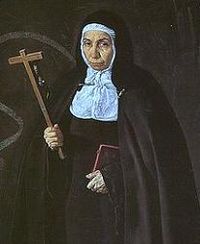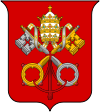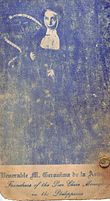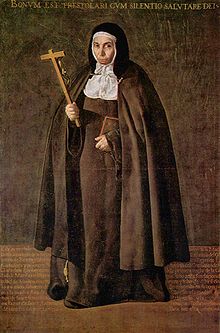- Jerónima de la Asunción
-
Jeronima of the Assumption 
professed religious, Poor Clare Nuns Born 09 May 1555
Toledo, SpainDied 22 October 1630
Manila, PhilippinesHonored in Roman Catholic Church Feast 22 October Mother Jerónima de la Asunción (or Jerónima de la Fuente) (May 9, 1555 – October 22, 1630) was the foundress of the first Catholic monastery in Manila and the Far East. De la Asunción's monastery became known as the Monastery of Santa Clara in Intramuros, Philippines. For De la Asunción's efforts as the first founding missionary woman in the Philippines, the Vatican had issued an apostolic decree for her beatification in 1734. De la Asunción's monastery in Intramuros was also immortalized in the novel, Noli Me Tangere, written by José Rizal.[1][2]
Contents
Biography
Jerónima de la Asunción was born in Toledo, Spain to Christian parents, Pedro Garcia-Yanez and Catalina de la Fuente. Her parents were both native to Toledo and were of noble lineage. Jerónima spent her childhood in Toledo, where she learned the basics of Christian life at a very early age. At the age of fourteen, she met Teresa of Ávila in Toledo. After that meeting, she felt the calling to a religious life. She was also influenced by the biography of St. Claire of Assisi. On August 15, 1570, Jerónima entered the Franciscan convent of Santa Isabel la Real de Toledo. At this convent, she joined two of her aunts who were already professed nuns at the time. She later occasionally functioned as Mistress of Novices.[1][2]
Voyage to the Far East
Although de la Asunción learned about the intention of her congregation to establish a monastery of nuns in Manila, it was only on October 21, 1619 when she received approval to travel. The prelates appointed Fray José de Santa Maria, O.F.M. as procurator to arrange the royal travel permits for her, while de la Asunción herself was appointed as foundress and first abbess of the Philippine monastery. The Philippine monastery would be the first of its kind to be established both in Manila and in the Far East.[1]
De la Asunción's journey began in April 1620, with the initial group of six Poor Clare nuns. De la Asunción was already 66 years old. From Toledo, they sailed by boat to Seville, Spain, where they were joined by two more nuns, and then they traveled on to Cádiz, Spain. From Cadiz, the group sailed on to cross the Atlantic Ocean. By late September 1620, the nuns reached Mexico City and stayed there for less than six months. Two more nuns joined the group.[1]
On Ash Wednesday of 1621, de la Asunción and her group left Mexico by road to cross the mountains towards Acapulco city. On April 21, 1621, the group boarded the galleon, San Andrés for the Philippines.[1]
The women kept a record of their travel from Toledo to Manila. One of the nuns died as the San Andrés galleon was crossing the Pacific, near the Marianas. The rest of the group set foot in the Philippines through the port of Bolinao on July 24, 1621. They reached Intramuros, the center of Manila at the time, on August 5, 1621. Their trip from Toledo to Intramuros lasted one year, three months and nine days.[1]
Later life, death and beatification process
During the last thirty years of her life, de la Asunción lived in constant illness. In early September 1630, her health deteriorated. She died at dawn on October 22, 1630 at the age of 75.[1] De la Asunción's remains were first buried in a niche within a wall inside the monastery that she founded, but later experienced five relocations. The first was in 1670 to hinder the activities of local devotees. The second happened in 1712 due to the monastery's reconstruction. At the time, they were placed in the lower choir of the nunnery. The third relocation was during the British invasion of Manila in 1763, when the box containing De la Asunción's relics was transferred to the Church of St. Francis in Intramuros. The remains were brought back to the St. Claire monastery in 1765. De la Asunción's remains survived a bombing of the monastery during World War II. In the 1950s, her bones were finally placed permanently at a new monastery at Quezon City, Philippines.[1]
Although not born in the Philippines, Jerónima de la Asunción became a religious inspiration for many Catholic devotees. She was described as a woman of resolute character in managing political and religious conflicts within and outside the confines of her convent. Steps towards her beatification begun in 1630.[1]
Portraits of Jerónima de la Asunción
Modern-day photographs and images of Jeronima de la Asunción are replicas of the painting by the Spaniard court painter, Diego Velázquez. The portrait was composed during De la Asunción's stop-over in Seville, Spain, in 1620. The painting is described to convey the then sixty-six year old nun's "devoutness and strength of character through her stern expression and rugged countenance; her direct, outward gaze at the beholder; and her expressive accoutrements". De la Asunción was then wearing a dark, sober habit while holding a tome and a crucifix. There were inscriptions on the painting. The text across the top of the canvas read "It is good to await the salvation of God in silence", while the ribbon that flows from De la Asunción's mouth stated "I shall be satisfied as long as He is glorified".[2][3][4]
See also
- The First Filipino Saint
- Chapel of San Lorenzo Ruiz, New York
- Ignacia del Espiritu Santo
- The Religious of the Virgin Mary
- Three Fertility Saints of Obando, Bulacan, Philippines
- The Poor Clares
- The First Filipino Nun
References
Footnotes
- ^ a b c d e f g h i Ruano, Pedro, O.F.M. (Vice-General Postulator). Mother Jeronima de la Asunción (1555-1630), A Biography, Monastery of St. Claire, Quezon City, Philippines, 1999.
- ^ a b c Serrano, Hanna, Tanya J. Tiffany and Ronald E. McNair. Mother Jeronima de la Fuente: Founder of First Convent of Nuns in the Philippines, A Woman Religious and Reflection of Christ, University of Wisconsin, Milwaukee, retrieved on: June 17, 2007
- ^ Zirpolo, Lillian. Madre Jeronima de la Fuente and Lady With A Fan Two Portraits by Velasquez Reexamined, Woman's Art Journal, Vol. 15, No. 1 (Spring - Summer, 1994), pp. 16-21, JStor.org, retrieved on: June 24, 2007
- ^ Great Masters Gallery, Diego Rodriguez de Silva Velazquez Art Reproductions, Jeronima de la Asuncion, c.1620, 79 x 51 cm, The Wallace Collection, London, UK, 2007, retrieved on: June 24, 2007
Bibliography
- Claussen, Heather L. and Ann Arbor. Unconventional Sisterhood: Feminist Catholic Nuns in the Philippines, Issue 8, The University of Michigan Press, 2001, and A Review by Carolyn Brewer, Murdoch.edu.au, October 2002, retrieved on: June 17, 2007 - ISBN 0477211221 X (hard cover)
- Lally, Father Campion, O.F.M. (Note: F. C. Lally is a missionary in Japan who has been chaplain to the Poor Clares in Japan for 49 years). Poor Clare Bibliography, Poor Clare.org, retrieved on: June 17, 2007
- Tantingco, Robby. First Filipino Nun was Kapampangan (Note: The first Filipino nun, Martha de San Bernardo, was under Doña Madre Jeronima de la Asunción's congregation), Sunstar.com, March 6, 2007, retrieved on: June 18, 2007
- Brewer, Carolyn. Holy Confrontation: Religion, Gender and Sexuality in the Philippines, 1521-1685 (Note: This is an article mentioning Jeronima de la Asunción and the Poor Clare's Bolinao Manuscript), Issue 8, October 2002, Manila: Institute of Women's Studies, St. Scholastica's College, 2001, 437 pp., and A Review by Barbara Watson Andaya, retrieved on: June 18, 2007 - ISBN 971-8605-29-0
- Bourne, Edward Gaylord. The Philippine Islands, 1493-1803: Explorations, 1905, retrieved on: June 17, 2007
- Sanchez C. La Madre Jerónima de la Asunción y su fundación del monasterio de Santa Clara de Manila, Incidencias y consecuencias (Mother Jeronima of the Ascension and the Foundation of the Monastery of Santa Clara of Manila. Incidents and Consequences), Archivo franciscano Ibero-Oriental (Language: Spanish), Madrid, Espagne, 1994, Vol. 52, No. 205-06, pp. 379-400, Publisher: Padres Franciscanos Españoles, Madrid, Espagne, 1943, and Cat.Inist.fr, retrieved on: June 18, 2007 - ISSN 0042-3718
- Intramuros, Historic Walled City of Manila, Santa Clara Monastery, WordPress.com, February 19, 2007, retrieved on: June 18, 2007
- Monasterio de Santa Clara, Katipunan Avenue and Aurora Boulevard, Quezon City, Manila, Philippines, MyTravelGuide.com, retrieved on: June 18, 2007
- 99 Kapampangan Who Mattered in History and Why, Center for Kapampangan Studies, HAU.edu.ph and Geocities.com, 2007, retrieved on: June 23, 2007
- Pascual Jr., Federico D. Religious Firsts, Postscript, ABS-CBN Interactive, ABS-CBNNews.com, March 6, 2007, retrieved on: June 23, 2007
External links
Filipino Saints, Blesseds and Servants of God Saints 

Blesseds Venerables Servants of God Dionisia de Santa Maria Mitas Talangpaz • Cecilia Rosa De Jesús Talangpaz • William Finnemann • Alfredo Maria Aranda Obviar • Joaquina Maria Mercedes Barcelo Pages • Francisca del Espiritu Santo Fuentes • Aloysius Schwartz • Eugenio Sanz-Orozco Mortera • Dom Justo Takayama • Jerónima de la Asunción • Maria Beatriz Del Rosario Arroyo • Teofilo Camomot • Carlo Braga* • Rhoel Gallardo* • Alfredo Versoza*(*without nihil obstat)Roman Catholicism in the Philippines Apostolic Nunciature to the Philippines · Catholic Bishops Conference of the Philippines · Christmas · Dioceses · Filipino Saints · Military Ordinariate of the Philippines · Separation of Church & StateReligion in the Philippines Abrahamic Bread of Life Ministries International · Cathedral of Praise · Christ's Commission Fellowship · Christian and Missionary Alliance · Day by Day Christian Ministries · Greenhills Christian Fellowship · New Life Christian Center · True Jesus Church · Victory Christian FellowshipAssemblies of God · Cathedral of Praise · Foursquare Gospels · Jesus Is Lord Church · Jesus Miracle Crusade · Kingdom of Jesus Christ · Pentecostal Missionary Church of Christ (4th Watch)Anglican Communion (Episcopal) · Baptist · Baptist Bible Fellowship International · Christ Centered Church · Iglesia Evangelica Metodista · Iglesia Unida · Lutheran · Presbyterian · Salvation Army · United Church of Christ · United MethodistEthnic/Folk Indian Others Categories:- Spanish expatriates in the Philippines
- 1555 births
- 1630 deaths
- Spanish Roman Catholic nuns
- Female religious leaders
- 16th-century Spanish people
- 17th-century Spanish people
- Velazquez portraits
Wikimedia Foundation. 2010.


